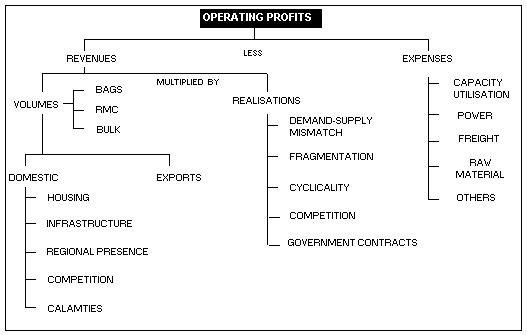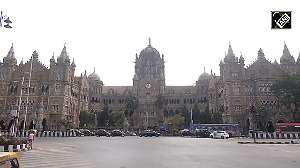Profile
Since cement is essentially a commodity, brand premium is almost non-existent in the industry. In terms of value-addition, this sector ranks below even steel and aluminium. It is a highly capital-intensive industry. A green field project for 1 MT requires capital expenditure to the tune of Rs 300 crore (2 MT is a ideal size for a company to have some kind of economies of scale). The sector operates with a high level of fixed cost (maintanence cost is around $5 per tonne annually) and therefore volume growth is critical. Access to raw materials (limestone and coal) and consuming markets are equally important in the long term.
The Indian cement industry has to be viewed on a regional basis viz. northern, western, southern and eastern. Since demand is unfavorable in certain regions, cement companies that focus on these regions are affected if there is a decline in prices.
The Indian cement industry is also highly fragmented with the top six accounting for about 60 per cent of industry capacity. The rest 40 per cent is distributed among 40 small players. The cement industry in India has emerged as the second largest in the world, boasting of a total capacity of around 144 m tonnes (including mini plants). However, on account of low per capita consumption of cement in the country (110 kgs/year as compared to world average of 260 kgs) there is still a huge potential for growth of the industry.

Let us throw some light on the various operating parameters presented in the flow chart above:
Operating profits: The operating profit of a cement company is nothing but the difference between the revenues earned and the expenses incurred. We shall now focus on the revenue side first. Revenues generated, is a function of volumes i.e. the quantity of cement sold multiplied by the price realisations.
Volumes: Cement selling, which was previously a 50 kg bag affair only, is now also being sold in the form of bulk cement as well as RMC (Ready Mix Concrete). Bulk cement (selling of cement in specially designed rakes) is especially useful for regular users of cement such a builders of large housing projects, as it ensures a continuous supply of pure cement, not touched by human hands.
RMC, on the other hand is a factory made concrete and a value added product that can be used for large construction projects, thus obviating the need to make concrete on the site and it also leads to quick delivery of fresh factory made concrete. However, these modes of selling still have a long way to go before making any impact and as a result, the majority of the cement (over 70 per cent) is still sold in bags.
The cement industry in the country is entirely domestic driven. As a result, exports account for very small percentage of the total cement off take in the industry. So, we focus more on domestic factors in this article. As far as the demand is concerned, more than half of the demand for cement comes from the housing industry. Infrastructure projects such as highway construction and construction of flyovers and ports also contribute towards the demand for cement. Moreover, certain calamities such as war and earthquakes can sometimes provide a short-term boost to the demand for cement in the country.
Apart from these external triggers, the company's strategy of locating its plants and the level of competition also has a bearing on the quantity of cement sold. Since cement demand is closely linked with the economic development, companies that have plants in regions of high urbanization and industrialization are better placed than their counter parts. Also, the larger the number of players, the more difficult it would be to grab a larger pie of the market share.
Realisations:
Among the different factors that affect the realisations of a company, the demand-supply mismatch is the most important. The cement industry in the country has not been able to realise its full potential mainly on account of the high demand supply mismatch in the country. In FY03, the excess capacity in the country stood at more than 30 m tonnes and this resulted in the prices touching an all time low. This, more than anything, highlights the importance of the demand supply mismatch in the fortunes of the industry. Therefore, a retail investor has to keep a tab on demand growth and capacity expansion plans for players.
The level of fragmentation and competition also play an important role in determining the prices since the larger the number of players, the more difficult it would be to ensure stability in prices. Institutional sales or big government contracts are normally won through bidding and this can also help determine the level of prices for specific projects. Lastly, cement like any other commodity business is cyclical in nature and hence its realisations also depend upon the position of industry in the business cycle.
Having gone through the revenues part of the flow chart let us now glance through the expenses involved in the manufacturing of cement.
Expenses:
Capacity utilisation: Since the industry operates on fixed cost, higher the capacity sold, the wider the cost distributed on the same base. But one should also keep in mind, that there have been instances wherein despite a healthy capacity utilisation, margins have fallen due to lower realisations.
Power: The cement industry is energy intensive in nature and thus power costs form the most critical cost component in cement manufacturing (about 30% to total expenses). Most of the companies resort to captive power plants in order to reduce power costs, as this source is cheaper and results in uninterrupted supply of power. Therefore, higher the captive power consumption of the company, the better it is for the company.
Freight: Since cement is a bulk commodity, transporting is a costly affair (over 15 per cent). Companies, that have plants located closer to the markets as well as to the source of raw materials have an advantage over their peers, as this leads to lower freight costs. Also, plants located in coastal belts find it much cheaper to transport cement by the sea route in order to cater to the coastal markets such as Mumbai and the states of Gujarat and Tamil Nadu.
On account of sufficient reserves of raw materials such as limestone and gypsum, the raw material costs are generally lower than freight and power costs in the cement industry. Excise duties imposed by the government and labor wages are among the other important cost components involved in the manufacturing of cement.
Let us have a look at some of the key points that should be borne in mind while investing in a cement company:
Operating margins: The company should have a consistent record of outperforming its peers on the operational performance front i.e. it should have higher operating margins than its competitors in the industry. Factors such as captive power plants, effective capacity utilisation results in higher operating margins and therefore these factors should be looked into.
Geographical spread: Since cement is a regional play on account of its high freight costs, the company should not have all its plants concentrated in one region. It should have a geographical spread so that adverse market conditions in one region can be mitigated by high growth in the other region.
Important valuation parameters: Apart from the P/E ratio, the other important valuation metric to be considered while investing in a cement stock is the PCF ratio (Price to Cash flow). This ratio is important because cement is a capital-intensive industry and hence depreciation forms a huge part of the total outgo.
In the past decade, the growth in the cement industry has always been 2 oer cent-3 per cent greater than the GDP growth rate and as a result a cement stock should be given a P/E, which is a couple of percentage points higher than the GDP growth rate in the country. However, a company with consistently higher operating margins than its peers should command a higher valuation.
Equitymaster.com is one of India's premier finance portals. The web site offers a user-friendly portfolio tracker, a weekly buy/sell recommendation service and research reports on India's top companies.







 © 2025
© 2025